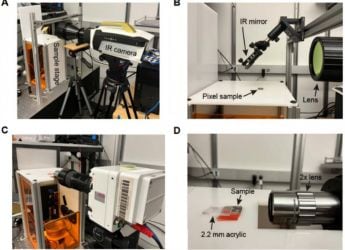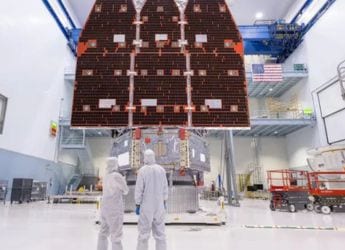- Home
- Science
- Science News
- Better Than Holograms? New Volumetric Display Tech Projects Onto Thin Air
Better Than Holograms? New Volumetric Display Tech Projects Onto Thin Air

One of the enduring sci-fi moments of the big screen - R2-D2 beaming a 3D image of Princess Leia into thin air in "Star Wars" - is closer to reality thanks to the smallest of screens: dust-like particles.
Scientists have figured out how to manipulate nearly unseen specks in the air and use them to create 3D images that are more realistic and clearer than holograms, according to a study in Wednesday's journal Nature . The study's lead author, Daniel Smalley, said the new technology is "printing something in space, just erasing it very quickly."
In this case, scientists created a small butterfly appearing to dance above a finger and an image of a graduate student imitating Leia in the Star Wars scene.
Even with all sorts of holograms already in use, this new technique is the closest to replicating that Star Wars scene.
"The way they do it is really cool," said Curtis Broadbent, of the University of Rochester, who wasn't part of the study but works on a competing technology. "You can have a circle of people stand around it and each person would be able to see it from their own perspective. And that's not possible with a hologram."
The tiny specks are controlled with laser light, like the fictional tractor beam from "Star Trek," said Smalley, an electrical engineering professor at Brigham Young University. Yet it was a different science fiction movie that gave him the idea: The scene in the movie "Iron Man" when the Tony Stark character dons a holographic glove. That couldn't happen in real life because Stark's arm would disrupt the image.
Going from holograms to this type of technology - technically called volumetric display - is like shifting from a two-dimensional printer to a three-dimensional printer, Smalley said. Holograms appear to the eye to be three-dimensional, but "all of the magic is happening on a 2D surface," Smalley said.
The key is trapping and moving the particles around potential disruptions - like Tony Stark's arm - so the "arm is no longer in the way," Smalley said.
Initially, Smalley thought gravity would make the particles fall and make it impossible to sustain an image, but the laser light energy changes air pressure in a way to keep them aloft, he said.
Other versions of volumetric display use larger "screens" and "you can't poke your finger into it because your fingers would get chopped off," said Massachusetts Institute of Technology professor V. Michael Bove, who wasn't part of the study team but was Smalley's mentor.
The device Smalley uses is about one-and-a-half times the size of a children's lunchbox, he said.
So far the projections have been tiny, but with more work and multiple beams, Smalley hopes to have bigger projections.
This method could one day be used to help guide medical procedures - as well as for entertainment, Smalley said. It's still years away from daily use.
Get your daily dose of tech news, reviews, and insights, in under 80 characters on Gadgets 360 Turbo. Connect with fellow tech lovers on our Forum. Follow us on X, Facebook, WhatsApp, Threads and Google News for instant updates. Catch all the action on our YouTube channel.
Related Stories
- Samsung Galaxy Unpacked 2025
- ChatGPT
- Redmi Note 14 Pro+
- iPhone 16
- Apple Vision Pro
- Oneplus 12
- OnePlus Nord CE 3 Lite 5G
- iPhone 13
- Xiaomi 14 Pro
- Oppo Find N3
- Tecno Spark Go (2023)
- Realme V30
- Best Phones Under 25000
- Samsung Galaxy S24 Series
- Cryptocurrency
- iQoo 12
- Samsung Galaxy S24 Ultra
- Giottus
- Samsung Galaxy Z Flip 5
- Apple 'Scary Fast'
- Housefull 5
- GoPro Hero 12 Black Review
- Invincible Season 2
- JioGlass
- HD Ready TV
- Laptop Under 50000
- Smartwatch Under 10000
- Latest Mobile Phones
- Compare Phones
- Jolla Phone
- Realme P4x 5G
- OnePlus Ace 6T
- Nubia Flip 3
- Nubia Fold
- OPPO A6x 5G
- Samsung Galaxy Z TriFold
- Poco F8 Ultra
- Asus ProArt P16
- MacBook Pro 14-inch (M5, 2025)
- OnePlus Pad Go 2
- Poco Pad M1
- Just Corseca Skywatch Pro
- Honor Watch X5
- Acerpure Nitro Z Series 100-inch QLED TV
- Samsung 43 Inch LED Ultra HD (4K) Smart TV (UA43UE81AFULXL)
- Asus ROG Ally
- Nintendo Switch Lite
- Haier 1.6 Ton 5 Star Inverter Split AC (HSU19G-MZAID5BN-INV)
- Haier 1.6 Ton 5 Star Inverter Split AC (HSU19G-MZAIM5BN-INV)

















